|
The FReeper Canteen Presents 
~Favorite Comedians~ The 1940's, Radio, Movies and Television 
Welcome to the FReeper Canteen! It's great to have you with us!!
Thank you to all of our Troops, Veterans, and their families for allowing us to entertain you! 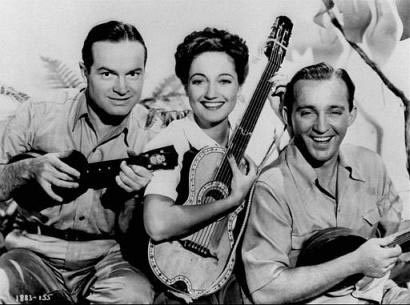
Television made its debut at the 1939 World Fair, but the war interrupted further development. The onset of U.S. involvement in WWII also brought a proliferation of movies. In 1947, commercial television with 13 stations became available to the public. Computers were developed during the early forties. The digital computer, named ENIAC, weighing 30 tons and standing two stories high, was completed in 1945. Radio was the lifeline for Americans in the 1940's, providing news, music and entertainment, much like television today. Programming included soap operas, quiz shows, children's hours, mystery stories, fine drama, and sports. Kate Smith and Arthur Godfrey were popular radio hosts. Like the movies, radio faded in popularity as television became prominent. Many of the most popular radio shows continued on in television, including Red Skelton, Jack Benny, and Bob Hope. Red Skelton - Reckless Driving (Radio) Bob Hope with Guests Doris Day and Jack Benny (Radio) Blondie & Dagwood - Circus Outing (Radio) 
Jack Benny grew up in Waukegan, Il. and went on the vaudeville stage in his early teens playing the violin. The instrument quickly turned into a mere prop, and his lack of musicianship became one of the staples of his act. Benny's first major success was on the radio. He starred in a regular radio program from 1932 to 1955, establishing the format and personality he would transfer almost intact to television. Benny's stage character was a clever inversion of his actual self. Though the character was named Jack Benny, he was also just about everything the actual Jack Benny himself was not: cheap, petty, vain and self-congratulatory. His masterful comic rendering of these traits became the vital linchpin to the Benny show's success. Benny set himself up as the comedic foil, allowing his supporting characters to draw laughs at the expense of his stinginess, vanity, and pettiness. By allowing such a character to be seen as human and vulnerable, in an era where few male characters were allowed such obvious vulnerability, Benny made what might have been a despicable character into a lovable Everyman character. Benny himself said on several occasions: "I don't care who gets the laughs on my show, as long as the show is funny." 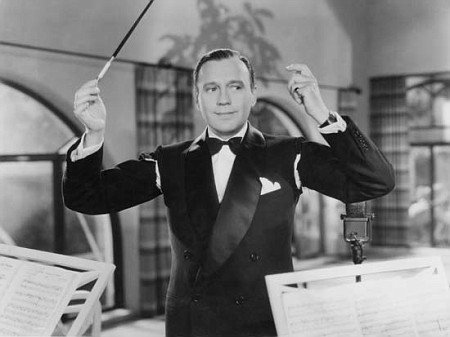
Jack Benny at Camp Haan - Part 1 Jack Benny at Camp Haan - Part 2 Jack Benny - Jack and Mary Go Christmas Shopping (Radio) 
Born in Vincennes, Indiana, Red Skelton was the son of a Hagenbeck-Wallace Circus clown named Joe who died in 1913 shortly before the birth of his son. Skelton himself got one of his earliest tastes of show business with the same circus as a teenager. Before that, however, he had been given the show business bug at age ten by entertainer Ed Wynn, who spotted him selling newspapers in front of the Pantheon Theatre, in Vincennes, Indiana, trying to help his family. After buying every newspaper in Skelton's stock, Wynn took the boy backstage and introduced him to every member of the show with which he was traveling. By age 15, Skelton had hit the road full-time as an entertainer, working everywhere from medicine shows and vaudeville to burlesque, showboats, minstrel shows and circuses. 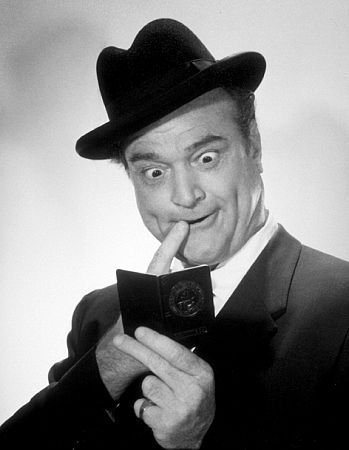
Red Skelton as Clem Kadiddlehopper Red Skelton in "Halloween" Red Skelton & Martha Raye in "Of Mouth And Men" Red Skelton's Pledge Of Allegiance 
In 1934-36, Milton Berle was heard regularly on The Rudy Vallee Hour, and he got much publicity as a regular on The Gillette Original Community Sing, a Sunday night comedy-variety program broadcast on CBS from September 6, 1936 to August 29, 1937. In 1939, he was the host of "Stop Me If You've Heard This One" with panelists spontaneously finishing jokes sent in by listeners. Scripted by Hal Block and Martin Ragaway, "The Milton Berle Show" brought Berle together with Arnold Stang, later a familiar face as Berle's TV sidekick. Others in the cast were Pert Kelton, Mary Schipp, Jack Albertson, Arthur Q. Bryan, Ed Begley, and announcer Frank Gallop. Sponsored by Philip Morris, it aired on NBC from March 11, 1947, until April 13, 1948. In 1948, NBC decided to bring "Texaco Star Theater" from radio to television, with Berle as one of the show's four rotating hosts. For the fall season, NBC named Berle the permanent host. His highly visual, sometimes outrageous vaudeville style proved ideal for the burgeoning new medium. Berle and Texaco owned Tuesday nights for the next several years, reaching the number one slot. Berle is credited for the huge spike in the sale of TV sets. (Other comedians turned this into a punchline: "I sold mine, my uncle sold his...") After Berle's show began, set sales more than doubled, reaching two million in 1949. His stature as the medium's first superstar earned Berle the sobriquet "Mr. Television." He also earned a slightly more familiar nickname after ending a 1949 broadcast with a brief ad-libbed remark to children watching the show: "Listen to your Uncle Miltie and go to bed." 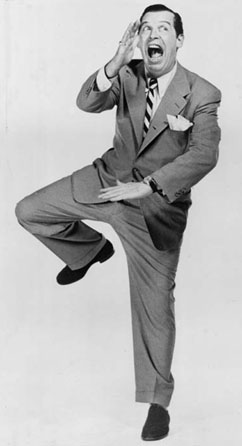
Milton Berle in "Always Leave Then Laughling" Milton Berle "Gets Told Off" 
As a movie star, Bob Hope was best known for "My Favorite Brunette" and the highly profitable "Road" movies in which he starred with Bing Crosby and Dorothy Lamour, (whom he had first seen performing as a nightclub singer in New York and subsequently invited to work with him on his USO tours). Lamour is said to have shown up for filming fully prepared with her lines, only to be baffled by completely new material which had been written by Hope's own staff of writers without the studio's permission.
Hope first appeared on television in 1932 during a test transmission from an experimental CBS studio in New York. His career in broadcasting spanned sixty-four years and included a long association with NBC. Hope made his network radio debut in 1937 on NBC. His first regular series for NBC Radio was the Woodbury Soap Hour. A year later The Pepsodent Radio Show Starring Bob Hope began, and would run through 1953. Hope performed his first United Service Organizations (USO) show on May 6, 1941, at March Field, California. He continued to travel and entertain troops for the rest of World War II and later during the Korean War, the Vietnam War and the 1990–1991 Persian Gulf War. When overseas he almost always performed in Army fatigues as a show of support for his audience. Hope's USO career lasted half a century, during which he headlined approximately sixty tours. For his service to his country through the USO, Hope was awarded the prestigious Sylvanus Thayer Award by the United States Military Academy at West Point in 1968. 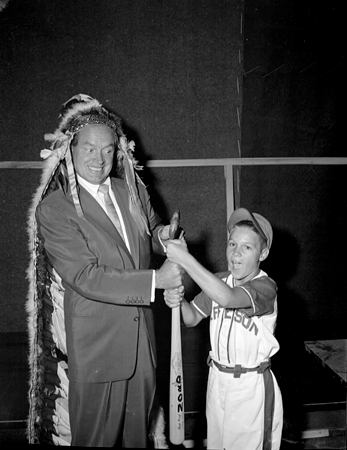
Bob Hope in "Kissing Lesson" Bob Hope in "My Favorite Brunette" Bob Hope sings "Captain Custard" 
FR CANTEEN MISSION STATEMENT~Showing support and boosting the morale of our military and our allies military and the family members of the above. Honoring those who have served before.
Please remember: The Canteen is a place to honor and entertain our troops. The Canteen is family friendly, and please leave politics at the door. Let's have fun! We pray for your continued strength, to be strong in the face of adversity.
We pray for your safety, that you will return to your families and friends soon.
We pray that your hope, courage, and dignity remain unbroken, so that you may show others the way.
God Bless You All ~ Today, Tomorrow and Always
|